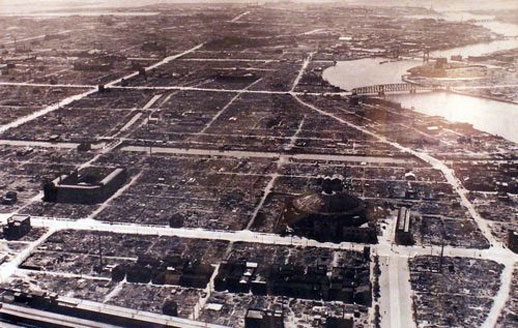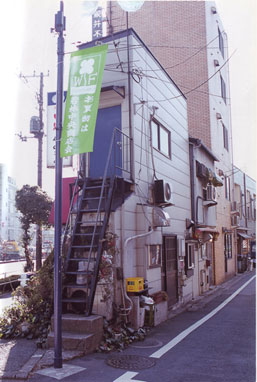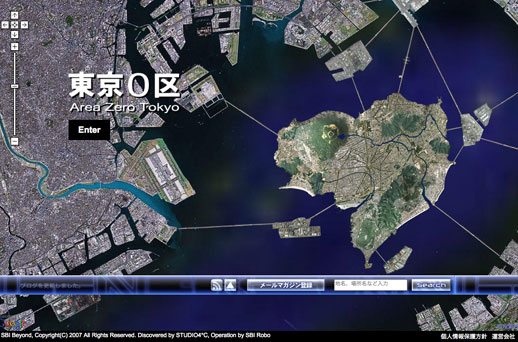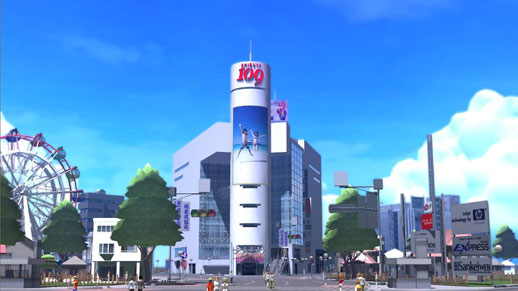Virtual Tokyo – Towards an Open Source Urbanism
Despite retaining the memory of one of the most persistent and fierce bombardments known to human history and having been reduced to ashes sixty years ago, the rate of Tokyo’s metabolism since then has been well above its inhabitants’ capacity to comprehend it. The dynamics that drive the city today are epitomized by mega-commercial complexes and urban redevelopments of a kind that deny the histories that characterize specific localities. The majority of cultural facilities such as museums and art centers too, regardless of whether they are publicly or privately run, take visitor numbers as their sole, short-sighted criterion for their assessment of performance, as opposed to a longer-term evaluation of their cultural integration. In an urban landscape generated by such capitalistic hegemony, communities that were fostered on the basis of the characteristic properties of a locality face the threat of eradication; the sense of living in Tokyo as a particular locality is disappearing.

The problem lies in the fact that it continues to be only a small number of giant real-estate business corporations and general constructors, as well as the inflated advertising agencies that control the realization and representation of the city. Such capital-driven urban planning (a scheme that art critic Sawaragi Noi once denoted as ‘capitalist realism’, playing on the existing term ‘socialist realism’) proliferates an archaic form of social engineering in which a small minority makes arbitrary decision in disregard of social consensus.
This condition, which we may call a form of obscurantism in urban planning, is far from being cast aside. Based on the case study of the transitions in the administration of Tennoji Park in Osaka, sociologist Takashi Sakai constructed a model for the critical analysis of the proliferation of public spaces conceived as devices for attracting visitors. In this case study, Sakai identified a transition from an ‘urban managerialism’ to an ‘urban entrepreneurship’1, and I believe the same phenomenon can be observed in the mega cultural complexes in Tokyo or, to raise a specific example, in the redevelopment of Shimokitazawa.2
A legitimate historicity cannot be obtained without Tokyo’s prochronism3 being shaped according to the decisions of the city’s inhabitants. Tokyo is currently the stage for a most radical and fierce marketing warfare: the ‘scrap and build’ approach to urban infrastructure that has grown in tandem with this has hardly been experienced so thoroughly and continually in any other city as it has here. This could of course be evidence that the city has a firmly established metabolism, but at the same time it is inextricably linked with a fundamental cultural crisis, namely the loss of a common and sharable history. The urban space that inevitably results in these circumstances endures a slow death in which there are no records of the past generated by the city itself, local cultures are standardized and the self-regulatory power of inhabitants’ activities is undermined.
Legitimate history can become the starting point for the development of publicness. The basis for this value judgment lies in the theory propounded in architectural historian Kaichiro Morikawa’s Learning from Akihabara: The Birth of a Personapolis. Morikawa presents an evolutionary view, illustrating the historic change in the primary driving force in urban formation, namely the transition of power from the government to the people, and then to the individual. As a valuable example of this final transition, Morikawa cites Akihabara in the late 1990s and early 2000s, an urban area that – unlike either the government-led construction of the Nishi Shinjuku skyscraper district, or the formation of Shibuya and Omotesando by private corporations – experienced a redefinition of its surface and structure in accordance with the personal tastes of otaku, a group of de-social individuals who are neither part of ‘the government’ nor ‘the private sector.’ Indeed, the city’s train station, building façades and pavements were flooded with local Anime and Video Game icons, and even commercial billboards were filled with domestic TV celebrities, in contrast to advertisements in Shibuya and Omotesando that are predominantly display figures from abroad.4
The value that Morikawa found in Akihabara resonates with the following question posed by the architectural unit Atelier BowWow.
Isn’t public space following a dark scenario today? It is engulfed by commercial space, its purposes are tightly arranged, it is under surveillance and it is increasingly losing those characteristics that cultivate redundancy such as surplus, variability and diversity.5

In observing and analyzing what they refer to as Tokyo’s dame kenchiku (bad architecture), Atelier BowWow has developed the concept of “Pet Architecture,” also called “Non-Pedigreed Architecture”: these are defined as buildings bigger than dog houses but smaller than human houses, but then derived to dissimilated spaces in general, characterized by their site-specific mutations that were not part of their initial conception. Due to the lack of assistance from the authorities and urban planners, these spaces are the product of the self-build efforts of the inhabitants. They reveal the process of inhabitants proactively redefining their space, customizing an environment strongly restricted by the scarcity of the land available.
Both Morikawa’s analysis of otaku behavior in relation to urbanism and Atelier BowWow’s research into dissimilated space took Tokyo as their base and share the notion of ‘play’ as a key factor in the urban equation. This points to a fundamental difference between this approach based on the characteristically Japanese “de-socialized creativity” and the revolutionism that presupposes the Western concept of the individual authorship in creativity. Here we can see a direct connection with the attitude of the Situationists in 1950s and 1960s Europe: “The economic objection fails at first sight. The more a location reserves the freedom of play, the greater its influence on behavior and the greater its power of attraction”6. The reason why ‘play’ resonates with the concept of art is because of its inclination towards the acceptance of ‘non-values’7, that is to say emerging cultural substances that have not yet been adopted by pre-existing social paradigms. However, in a world driven by capital, where all values are judged within the confinement of the single standard of economic value, pure ‘play’ is hedged as an unmanageable phenomenon. Furthermore, this war of power over ‘play’ is not only being fought in the real world but also within cyberspace.
The Internet has been the stage of a variety of conflicts in which users strive to maintain the right to generate and decentralize information, in other words conflicts over gaining the primary position in the construction of history.
Twenty years ago, Richard Stallman initiated the free-software movement, leading directly to the birth of open-source software. Today, open-source software has become an industry of its own with mega-corporations such as IBM participating, and recently it has inspired the rise of ‘open-culture,’ notably the Creative Commons movement, started by Lawrence Lessig and other scholars and practitioners. These movements consist of allowing the creators of information to yield a certain number of rights attributed to their content when publicizing it on the Internet, allowing others the freedom to create derivative works based on them. However, although the boundary that separates the market and the non-market is gradually becoming more and more blurred, there is still fierce antagonism felt from vested interests such as TV networks, record companies and collecting societies. The only possible evolutionary step beyond this conflict is the development of a moderate middle ground that reduces the distance between the two polarities, thus deriving more space for alternatives.

What then is the relationship between the city of Tokyo and the Web? Three-dimensional virtual worlds known as ‘metaverses’ are being developed as a continuation of the two-dimensional interfaces of web browsers. The private sector is currently taking advantage of these metaverses to engage in a capitalistic colonization of cyberspace. SBI (Strategic Business Innovator, formerly SoftBankInvestment) is now initiating a virtual urbanism project titled ‘Tokyo Zero-ku’ (Tokyo 0 District)8 that would fill Tokyo Bay with an imaginary three-dimensional island, carefully designed by anime directors and artists. The intention is to create a cyber-marketplace where investors and entrepreneurs would meet, discuss, and engage in financial transactions on a daily basis. SecondLife9, the largest metaverse in the world run by LindenLab, was conceived as a platform open to anyone to build houses and create objects freely, but recently corporate developers are overriding user-generated content. For instance, many areas with the names of Tokyo localities are being bought and developed by private companies as Japanese living quarters ‘Japan’ or ‘Tokyo’, and Japan’s largest advertising agency Dentsu has developed an area named ‘Virtual Tokyo’ in a top-down manner. All the more, an online service called Meet me10 has gone even further, adopting a configuration that appears to have been directly copied off real world Tokyo.11

These different trends in the informatization of Tokyo are nothing more than arbitrary formulations of diverse possible worlds, and have naturally not had any effect in on everyday life in real world Tokyo. However, there are movements within cyberspace that could potentially assume a function in the construction of Tokyo’s originality. The most prominent examples are ubiquitous computing and mobile devices that enable network connectivity anywhere in the city, and the life log system that transmits all biological information of the user to such networks. For example, the Place Engine developed in the Sony CSL is a technology that enables high precision location detection using existing WiFi networks scattered around the city. The ‘My Maps’ function on Google Maps also allows each user to freely write information onto the map of Tokyo and disclose it at different levels of access. Nike+iPod offers the possibility of personal information such records of one’s jogging route being shared all around the city. This trend to bridge the gap between personal information and social functions is being initiated in cyberspace and, over time, will increasingly connect with the concerns surrounding urban space in real-world Tokyo.
The history building of Tokyo’s is now at stake in the merging field that bridges the real world environment and cyberspace, between the corporate entrepreneurship and local inhabitants’ autonomy. The open source approach on urbanism will be especially valid for the city of Tokyo, for the media technologies and the dynamics of the Web already started to pervade the megalopolis. And this revolution must inspire playfulness to its participants, not security nor cleanness.
—
1 Takashi Sakai, Park in “Virtualism”, 10+1 no.45, 2006, INAX This is a term coined by geographer David Harvey to describe the transition from bureaucrat-led managerialism to a capitalistic control of urban planning. See Harvey, D. (1989) ‘From managerialism to entrepreneurialism: the transformation of urban governance in late capitalism’, Geografiska Annaler 71B: 3–17.
2 See Matias Sendoa “Echanove, Urban Ecology & Man-Made Disaster in Shimokitazawa”, 10+1 No.45 (INAX Publishing, 2006.12)
3 Prochromism: the standard definition is “the dating of an event before the time it happened, an antedating – as opposed to metachronism”. However: prochronism is also defined by cybernetician Gregory Bateson as a history of how a series of formal problems were solved in living organism.
4 However, in spite of the notions of libertarian self-government that such an otaku-polis implies, under the pressure of redevelopment and mainstream commercialization it has become a mere commercially driven façade in recent years. The otaku population does not take part in the process such as Public administration-led redevelopment and the commodification by the mass media. Refer to Shinji Miyadai/Kaichiro Morikawa, “The individual and the whole in a mobile society –Did Otaku create Akihabara?”, Miraishinri vol. 008, for more information.
5 Atelier BowWow, Ikiiki to shita kuukan (exhibition booklet) http://www.toto.co.jp/gallerma/ex070308/index.htm
It follows: “One of the ways that can lead to a breakthrough in this situation is to set into motion, through the practice of space based on the human body, the program for publicness that is intrinsic to everyone”
6 Gilles Ivain, “Formulaire pour un urbanisme nouveau”, Internationalie Situationniste, 1958 “L’objection économique ne résiste pas au premier coup d’oeil. On sait que plus un lieu est réservé à la liberté de jeu, plus il influe sur le comportement et plus sa force d’attraction est grande.”
7 Daniel Charles (trans. By Tetsuo Iwasa), Gloses Sur John Cage, Union Général d’Editions à Paris, 1978, chapter 17 “Cage et Duchamp”
8 http://www.tokyozeroku.com/
9 http://secondlife.com/
10 http://meet-me.jp/
11 It is worth mentioning that these online developments are not without some precedent in the real world. To raise an example in which an imaginary Tokyo was constructed, Kenzo Tange’s “Tokyo Keikaku 1960 (Tokyo Plan 1960)” was an immense, Le Corbusier-like national-level vision for filling the whole of Tokyo Bay with architectural modules.
Dominick Chen
Dominick Chen



